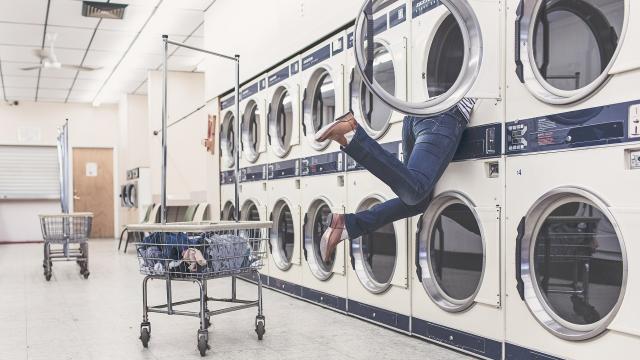While doing a load (or two) of laundry, I often wonder to myself: Between the chemical detergents, enormous water use, and the assistance of a dry cleaner with tricky stains, am I being a shitty environmentalist?
While I do my best, I certainly have room to improve (and dry cleaning, it seems, may be a habit I’ll have to wean myself off of). This week, Popular Science offered advice on how we can all be a little greener when it comes to our laundry rituals.
[referenced url=”https://www.lifehacker.com.au/2019/04/dont-throw-your-used-mattress-in-the-trash/” thumb=”https://i.kinja-img.com/gawker-media/image/upload/t_ku-large/rdoernhmfwwetafc1vjn.jpg” title=”Don’t Throw Your Used Mattress In The Garbage” excerpt=”Some items are easy to recycle, like a plastic bottle or newspaper. Other things are a lot more difficult, simply because they probably won’t fit in your average recycling bin—like a king-size mattress, for instance.”]
Use eco-friendly detergents
Perhaps the easiest way to be green with your laundry is to use a biodegradable detergent, as Popular Science recommends. Why? All detergents contain surfactants, which are responsible for removing all the grime from your dirty clothes. Once the detergent is drained, these surfactants enter our waterways like streams and rivers where high concentrations of them are toxic to aquatic life.
How can you avoid this problem? Try using an eco-friendly detergent that biodegrades within days of its use, creating less potential for water pollution. One trick to finding biodegradable detergents is searching for kinds that are made of plant-based ingredients, rather than petroleum-based. (These are much, much more likely to be biodegradable.) USA Today recommends brands like Mrs. Meyers and Method, both of which consist of mostly plant-based ingredients.
While shopping, you can pretty easily spot a biodegradable detergent or plant-based soap based on its label.
Grist has another key tip: Generally, powdered detergents are slightly better for the environment than liquid ones, as the latter tend to contain more surfactants, so go for powder whenever you can.
Use cold water
Yes, using hot water is the best idea when trying to properly clean clothes or get rid of stains. In other instances, like when trying to prevent shrinking or colour bleeding, cold water is the preferred method — and often, that’s the best solution for the environment, too.
Your money on water heating costs, too.
[referenced url=”https://www.lifehacker.com.au/2018/09/how-to-do-laundry-if-you-are-bad-at-laundry/” thumb=”https://i3.ytimg.com/vi/r_-PJPJqNgw/maxresdefault.jpg” title=”How To Do Laundry If You Are Bad At Laundry ” excerpt=”Video: So you’re bad at laundry. Maybe you’ve been able to come home from uni every weekend lugging a bag of dirty clothes like Santa, or maybe you never fully recovered from that lipstick-in-the-dryer incident of ‘08. We aren’t here to judge. We’re here to help. In this final episode of Lifehacker’s Adulting series, we go over some laundry basics.”]
Air dry your clothes
Your dryer uses a lot of energy. In fact, a new dryer can use as much energy as a new washer, refrigerator, and dishwasher put together, according to a 2014 report by the Natural Resources Defence Council.
The best answer to this problem is opting to air-dry your clothes. You’ll save energy and money — plus, air drying is best for keeping clothes intact. Drying them over and over again creates microscopic tears, wearing your clothes down until you throw them in the trash.
Buy clothing with natural fibres
As Popular Science wrote, some fibres are much, much better than others for the environment. Clothing made from synthetic fibres, like polyester, nylon, or acrylic, releases tiny amounts of fibre into our waterways with every single wash.
While numbers vary, one report estimates that 700,000 fibres come off in one wash alone. Another report estimates that 1,900 fibres are released from a single garment.
Many of these fibres are made of plastic and are considered microplastics, which contaminate our oceans and become toxic to wildlife. Purchase more clothing made from natural fibres, if you can, such as cotton, wool, and hemp.
Use a dry cleaner sparingly
What’s so wrong with dry cleaning? Many dry cleaners across the U.S. use a cleaning solvent known as perchloroethylene, or “perc.” In fact, across some 36,000 garment care facilities, it’s estimated some 85 per cent of them use perc. It can cause health effects in people like dizziness and nausea and is identified as a “probable carcinogen” in the state of California. It’s also been shown to cause cancer in animals.
Using your dry cleaner a little less is will certainly help curb the problem. Or do an online search for green dry cleaners that don’t use perc in their cleaning process. Currently, the two most environmentally friendly dry cleaning processes are wet-dry cleaning and liquid carbon dioxide cleaning.
Wet-dry cleaning uses green, mild detergents in its process; the latter captures carbon dioxide as byproduct from industrial processes, requiring little resources.
You might find a green cleaner that uses either hydrocarbon solvents or silicon-based solvents. Both are better than your standard perc dry cleaner, though still involve some degree of environmental waste. Just ask your cleaner what they use before handing over your clothes so you can get the best insight as to your impact on the environment.

Comments